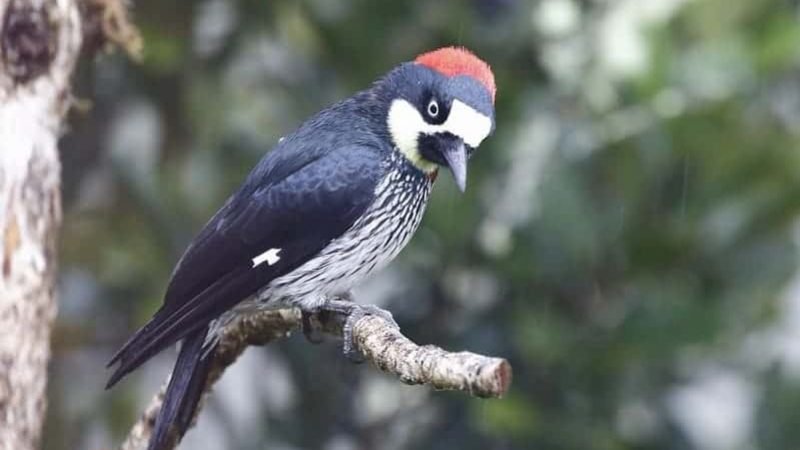
Colorado is a beautiful state filled with a wide expanse of natural elements that are very appealing to a large range of wildlife including many different kinds of birds.
This state is known for its many forests and large State Parks that are often the perfect backdrop for all kinds of wildlife to flourish.
Though there are many birds that call Colorado home, it is known for its wide collection of woodpecker species that frequently inhabit the state.
These birds are partial to wooded areas, which Colorado has an abundance of.
For this reason and more, you can find up to twelve different woodpecker species within the state on a fairly regular basis.
Want to learn more? Take a look at the North American Guide to Woodpeckers
The State Parks in particular are great for a vibrant bird watching experience.
In Colorado, there are a wide range of natural elements that can appeal to different preferences.
The state is known for its differing weather patterns, which can change on the drop of a dime. It has very warm summers and very cold winters, making it preferred by migratory and nonmigratory birds alike in the area.
This particular state plays home to a wide range of different habitats including deserts, forests, and much more.
It is perfect for appealing to all kinds of different animals, particularly woodpeckers looking for different kinds of trees to nest in.
It also offers a wide range of insects and other wildlife that contribute to the various ecosystems within the state.
Take a look at our article on How to Attract Woodpeckers?
What Woodpeckers can be seen in Colorado?
Table of Contents
1. Red-Naped Sapsucker
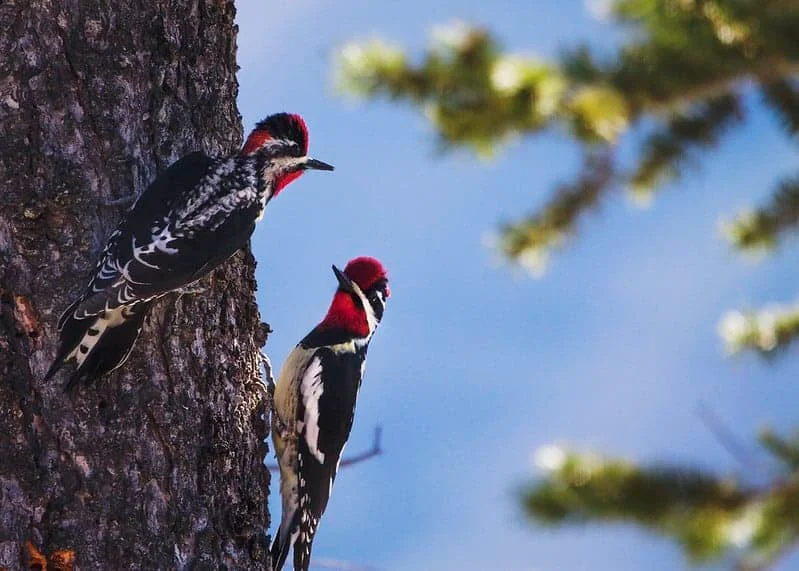
Wingspan
16inches
Weight
2.3 ounces
Life Expectancy
5 years
Diet
Sap, insects, fruit & berries
The Red-Naped Sapsucker is a bird with an endearing red stripe across its head that makes it easy to identify.
These birds are known for their fancy and bizarre courtship display which involves showing off the colored patch of feathers on the underside of their throats.
They are known to nest in tree cavities and unlike many other woodpeckers are actually known to nest in the same tree year over year. They also have a preference for nesting high off the ground.
This particular bird is a common resident during breeding season throughout the spring and summer months.
The Red-Naped Sapsucker finds Colorado to be a preferred breeding ground because of all of the trees that are available.
In winter, the numbers will generally thin as some of the birds head south to escape the cold. However, it is also common for more of the Red-Naped Sapsuckers to flutter down from northern states to Colorado.
The best way to find these birds is to go to an area with plenty of Aspen trees.
Many of Colorado’s mountain towns and cities, particularly Aspen and Estes Park, are known to have the perfect area for these birds to live.
They are more common in the western part of the state, likely because of the Rocky Mountains and their healthy supply of trees that are perfect for building nests and hunting.
Overall, you can find them looking for delicious food or drinking from trees in forested areas around the state.
2. Red-bellied Woodpecker
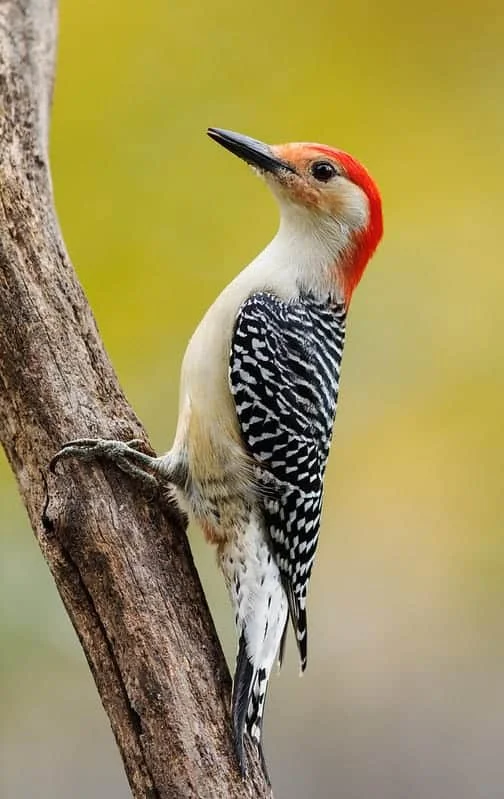
Wingspan
15-18 inches
Weight
2.65 ounces
Life Expectancy
12 years
Diet
Insects
The Red-Bellied Woodpecker is a beautiful bird that can easily be spotted by its vibrant red head that stands out from a great distance.
Even though they are called red-bellied, the reality is that these birds have a slight flush of pink across their bellies that can be fairly difficult to see.
When these birds mate, they do so for life and share the hatching duties. The females will stay with the eggs during the day and the male will generally stay with the nest at night.
These birds will fiercely guard their nests for about a month after the babies hatch to keep them fed, safe, and healthy.
In Colorado, the Red-Bellied Woodpecker can be found all around the year.
Though these birds don’t migrate, they are known to head down to lower elevations and even head south on occasion depending on how cold it gets.
Since Colorado has some fairly cold weather in winter, it is known to drive out some of the birds that would otherwise stay put under slightly warmer conditions.
If you are looking for the Red-Bellied Woodpecker in Colorado, you are in luck. These adorable birds are generally in abundance across the Rocky Mountains.
However, in Colorado, they are most commonly found on the eastern side of the Rocky Mountains. Still, they are in other naturally wooded areas around the state and will sometimes venture to less wooded areas depending on the weather.
3. Downy Woodpecker
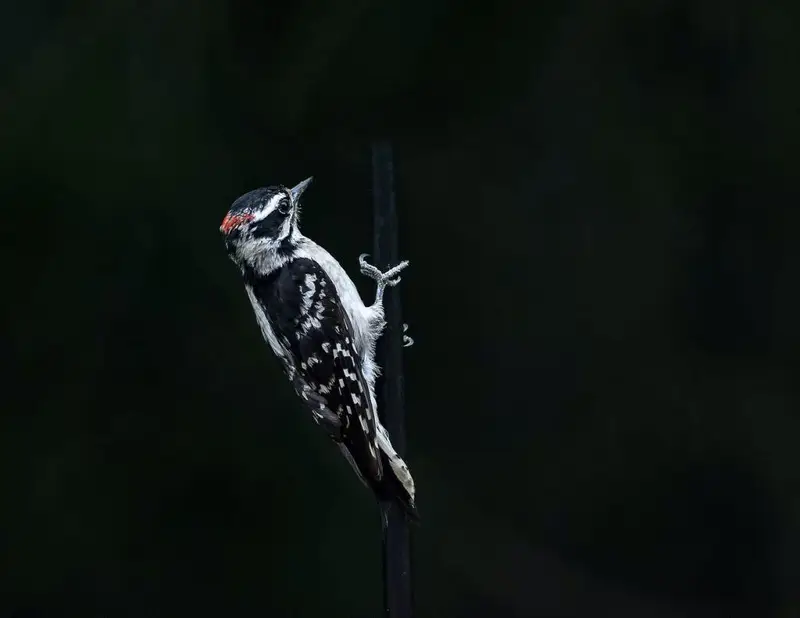
Wingspan
3.27 to 4.13 inches
Weight
0.75 to 1 ounce
Life Expectancy
12 Years
Diet
Insects & Non-insect arthropods
The Downy Woodpecker is a unique bird that is very similar to the Hairy Woodpecker, though quite a bit smaller.
This adorable bird is known for nesting in deadwood trees, sometimes at alarmingly tall heights.
This bird, in particular, is known for its unique parenting style. When the birds are nesting, they will both incubate the egg rather than just the female.
They will spend the full incubation period, roughly twelve weeks, keeping the eggs warm and making sure that their babies have the best possible change.
Spotting the Downy Woodpecker is a year-round affair that any Colorado citizen can manage in the right area.
Though they might be more active during mating season and then less active after their eggs have been laid, they are otherwise easy to spot during any time of the year as long as you know where to look.
In Colorado, the Downy Woodpecker is fairly easily spotted in any of the more natural areas.
The Rocky Mountains and surrounding areas provide the ideal space for these birds in particular.
Colorado’s somewhat frequent wildfires and controlled burnings make the state an ideal hunting ground for these unique birds, who actively prefer deadwood.
They can also be found along any of the Colorado riverbeds, but generally aren’t found in heavily populated areas.
These birds tend to prefer their peace and want little to do with suburban areas or city areas because of the ecosystem, or lack thereof.
4. Red-Breasted Sapsucker
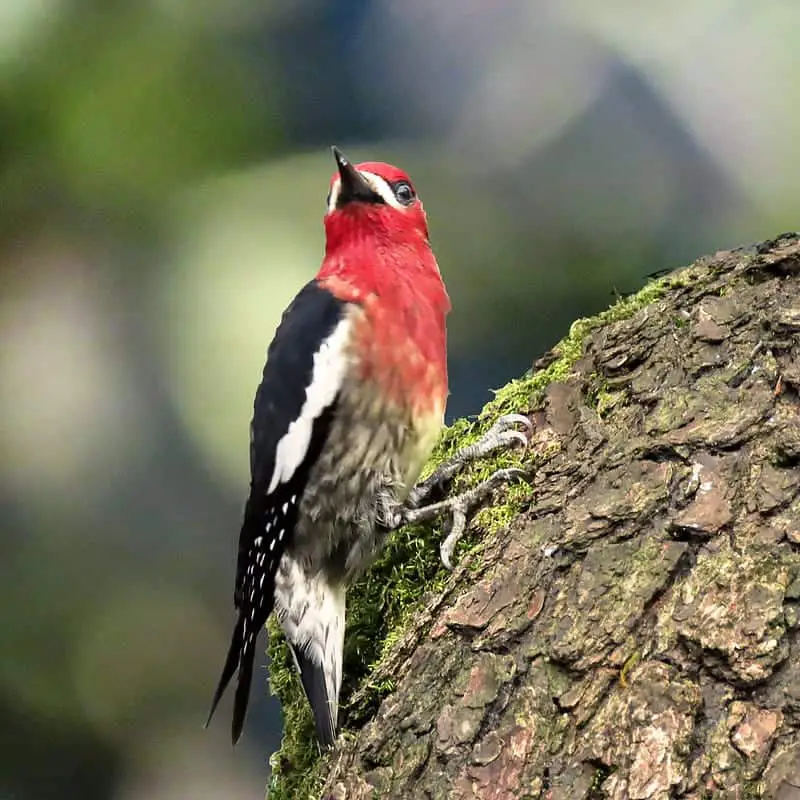
Wingspan
14 inches
Weight
2.2 ounces
Life Expectancy
3 years
Diet
Sap, fruit, insects & berries
The Red-Breasted Sapsucker is a simple bird that is here for a good time, not a long one.
These adorable birds, with their vibrant red necks and chests are an active kind of bird that are constantly looking for food and mates.
They opt for a simple nesting process, which includes utilizing cavities and holes within dead trees.
Unlike other woodpeckers, they are just as happy nesting in a branch as they are a primary trunk of a tree. Their nests are simple and do not have any additions prior to laying their eggs.
The Red-Breasted Sapsucker is generally considered to be a year-round bird, but exceptions may apply in Colorado.
This particular woodpecker is most commonly found on the actual west coast of the United States and Canada, and generally opts to move north for the breeding season and back down south in winter.
You are more likely to see them in Colorado during the winter months.
This particular woodpecker is known for its preference for coniferous forests, making it more likely to be found in the more wild side of Colorado, particularly the Rocky Mountains.
This woodpecker is always looking for a nice forest to spend time in, particularly in winter. Since they are less common in Colorado, you might not always be able to spot them.
However, the odd resident has managed to see them breeding near abandoned power lines in other somewhat occupied areas.
5. Hairy Woodpecker
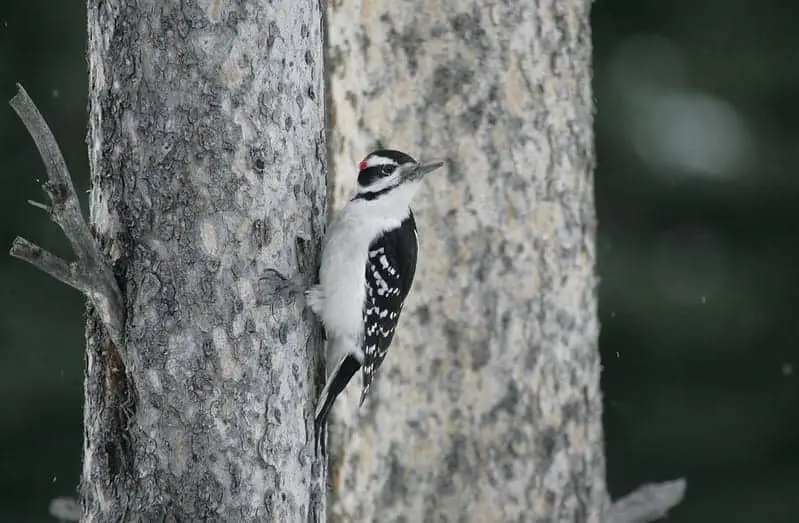
Wingspan
15 inches
Weight
1.4 to 3.4 ounces
Life Expectancy
15 years
Diet
Wood-boring insects & tree sap
This black and white marvel of a bird is known for its distant relation to the Downy Woodpecker.
The Hairy Woodpecker is, by most, considered to simply be a larger version of the Downy Woodpecker and it shares a lot of similarities including territory, but the two birds tend to focus on different parts of an area.
These birds enjoy nesting in large trees that allow for deep hollows.
Their nests can be anywhere between five and thirty feet off the ground, but their signature call, which is a sharp series of notes, makes it fairly easy to find them if they are in the area.
The Hairy Woodpecker can be found year-round in Colorado and is known for spending its days hunting around for bugs.
These unique birds can sometimes be seen in more populated areas, but generally prefer to spend their time in the forest unless the weather drives them to new areas to forage for food.
This particular bird is partial to Colorado because of its preference for food in wooded areas, particularly where dead wood is present.
This bird can be found up north near the many forest fire sites, as it enjoys searching this kind of wood for insects to eat. It is also easy to spot near Colorado rivers, particularly areas where there are many fallen trees.
6. Acorn Woodpecker
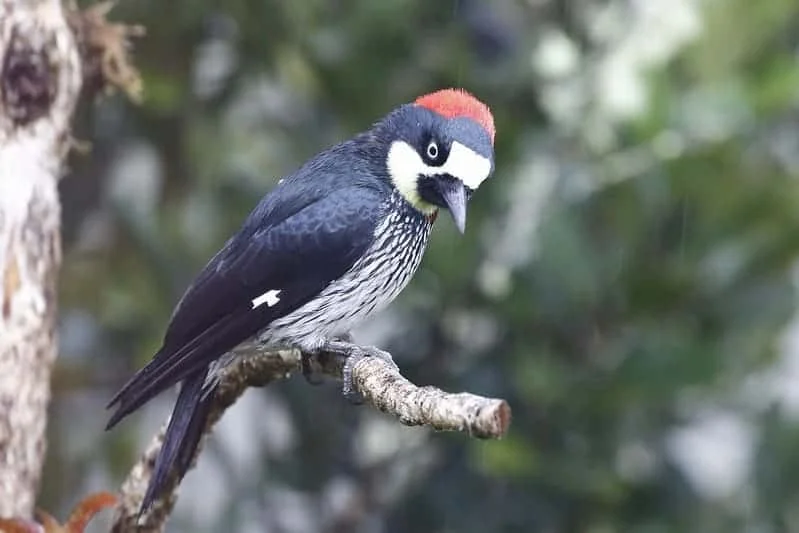
Wingspan
17 inches
Weight
3.2 ounces
Life Expectancy
17 Years
Diet
Insects, nuts, fruits and seeds
The Acorn Woodpecker is a red-headed bird that is known for its unusual excavation habits.
This funny and large woodpecker is known to spend a lot of its time drilling holes.
Unlike other woodpeckers that only create cavities to nest, the Acorn Woodpecker prefers to make a lot of different cavities that it can then choose from.
One lucky cavity will be chosen to help with the nesting, while the others will be used for simple roosting, particularly during the night.
What makes them even more unique is the fact that they will use these cavities for storage.
Though most people would never assume that a bird would actively store nuts or acorns, these ones do.
The squirrel-like Acorn Woodpecker has a penchant for drilling storage holes that can hold up to 50,000 nuts. They then use these holes to feed themselves and their families in winter.
The Acorn Woodpecker, as you might imagine, is known for spending its time in one location year-round.
You can spot them in Colorado with relative ease because of this. Even though they aren’t at their most concentrated, the local population is still dependable and can be found year-round.
Since these birds store their food for the long haul, it comes as no surprise that they like to stay put. If you see one, you will almost always be able to find them once again.
As far as preference goes, these birds prefer their share of oak and pine-oak trees. Fortunately, Colorado is abundant with plant life and suitable trees for them to live and nest.
They are most commonly found around the Rocky Mountains and are known to spend their time in lower elevations.
Though they do live in the mountains, they generally stay somewhat lower, opting to avoid those denser forests at higher elevations.
7. Ladder-Backed Woodpecker
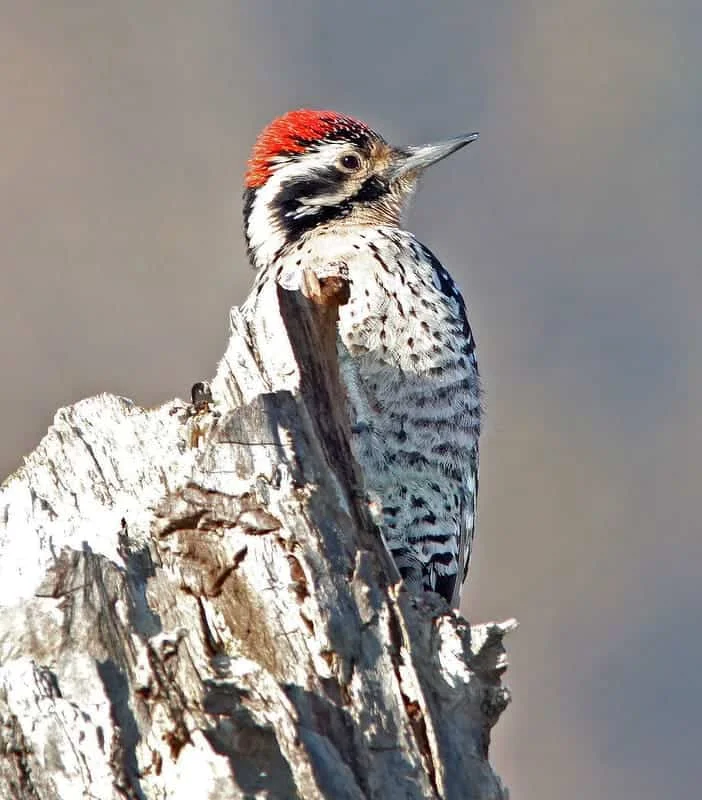
Wingspan
13 inches
Weight
2 ounces
Life Expectancy
5 years
Diet
Insects, larvae and some cactus fruits
The Ladder-Backed Woodpecker is an insectivorous woodpecker that loves to spend its time seeking out delicious bugs to gobble up.
It is known for nesting in trees, much like other common woodpeckers, but is a little more open-minded than some of the other birds.
In desert-like regions, they have been known to nest in cavities in cactuses, as well as other plants as needed.
The Ladder-Backed Woodpecker is a nonmigratory bird and will often stay in a single location for as long as nature allows them to.
As long as they have a good place to nest and some good insects to eat, they can be found in the same regions year over year.
These fun and vibrant birds may also move with the bug population, particularly if it gets quite cold.
Spotting the Ladder-Backed Woodpecker is largely a matter of going towards the southeastern side of Colorado.
It is most common in Mexico and Central America, but has been seen in fairly decent numbers towards the southern parts of other surrounding states.
You can find it in arid locations throughout the region.
Thankfully, it has a fairly recognizable black and white pattern that makes it stand out from the trees and cacti that it can be found on.
8. Yellow-bellied Sapsucker
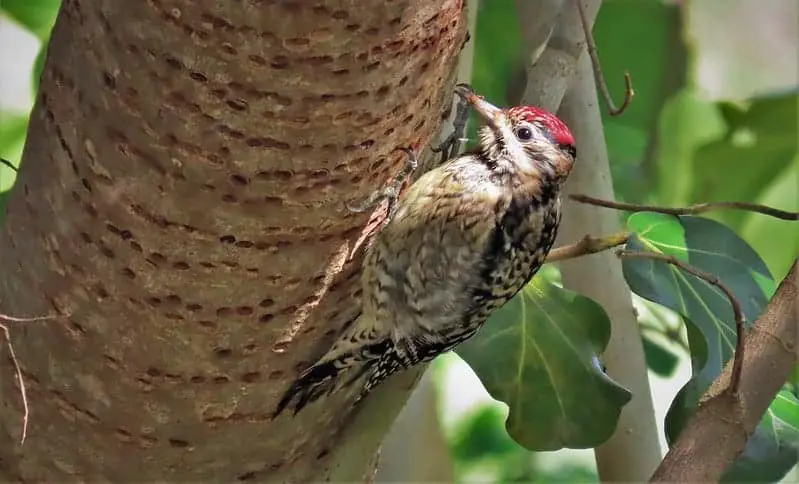
Wingspan
13 to 16 inches
Weight
1.5 to 1.9 ounces
Life Expectancy
7 years
Diet
Tree sap, insects & fruit
The Yellow-Bellied Sapsucker is an interesting and creative bird known for its odd habits.
When it comes to nesting, these birds, with their bright red heads and yellow bellies, will put the men to work.
Male birds will arrive at mating grounds early and spend several weeks digging out cavities for nesting.
Instead of stuffing their nests like many other birds, they instead allow the eggs to perch atop the bed of wooden shavings that are created during the excavation process.
Though these birds can be found in Colorado, they are not the most popular bird in the area.
These birds tend to prefer the eastern side of the country, but they can be spotted in Colorado during their migratory patterns, particularly the females who are known to prefer warm weather so much that they often head all the way to Central America.
You are more likely to see them heading down through the winter months to dodge the unfortunate cold in the area.
When these birds do spend time in the state, they can be found in any of the wooded areas around Colorado.
These birds prefer a heavy supply of healthy trees that they can enjoy drinking sap from.
Clever as they are, they have been known to grab the odd ant, dip it in sap, and then feast upon it for a delicious meal.
You are more likely to see them in young forests, particularly ones with a lighter spread of trees rather than an overly dense forest.
9. Northern Flicker
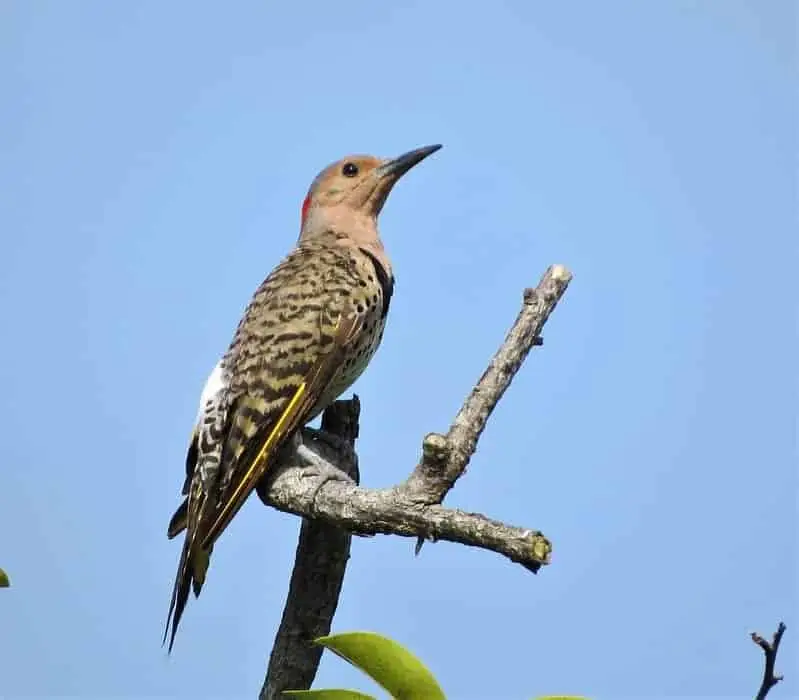
Wingspan
21.3 inches
Weight
6 ounces
Life Expectancy
9 Years
Diet
Insects, seeds, nuts & fruit
The Northern Flicker is a stunning bird most easily recognized by the salmon and yellow underside of its wings.
These interesting birds are common residents all over the country, but they have a surprisingly bad reputation in Colorado.
These adorable birds, while beautiful, are responsible for an overwhelming majority of woodpecker home damage in Colorado, making many residents take active steps to deter them.
The Northern Flicker can be found nesting in holes in trees, but has also been known to nest in the odd cavity around homes and other closed-in spaces.
Though most woodpeckers don’t actively migrate, the Northern Flicker is one of the unique species that do.
This means that the population of Northern Flickers in Colorado can vary greatly.
Some birds might migrate from up North when winter hits, while others in the areas might decide to head out and search for something even warmer than Colorado, which is known to get quite cold in winter.
Spotting these birds is a fairly easy process because of their unique look.
However, the damage that they do has led many populated areas to take some steps to deter them.
Since this is the case, it is not surprising that these birds are found more actively in slightly wooded areas where they can avoid such houses.
However, they are well known to be in suburban areas and cause their fair share of trouble.
10. Lewis's Woodpecker
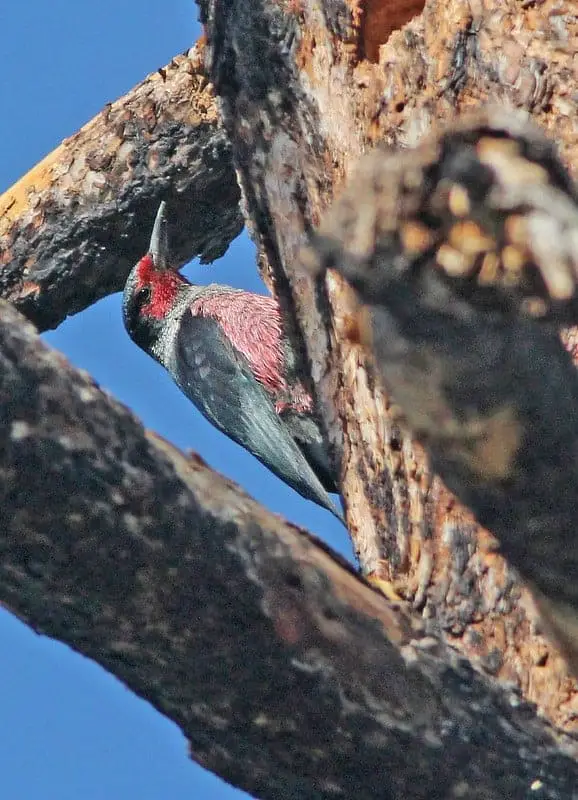
Wingspan
11 inches
Weight
4 ounces
Life Expectancy
4-11 Years
Diet
Insects & Nuts
Lewis’s Woodpecker, a bird named after the original explorer, is a beautiful and interesting bird that has almost no idea that it is a woodpecker.
Unlike many other woodpeckers, this particular bird prefers to hunt and forage in a way that is more suitable for crows and other birds instead of simply busting through wood to enjoy a snack like most others do.
These birds are known to nest in preexisting holes, with many showing a preference for existing woodpecker cavities or naturally formed ones.
However, they have been known to do some remodelling on occasion.
In Colorado, you can find this particular bird year-round in most places. Some may move a short distance north during the breeding season, but overall this bird is here to stay in the state and will often hang out in a specific area.
When winter hits, it is also fairly common for the birds in the northern part of the state to venture down south for a little while if the weather gets cold.
This varies year over year depending on the severity of the winter weather.
Colorado is a perfect habitat for this bird because Lewis’s Woodpecker has a preference for trees and forested areas.
You can find this woodpecker in the state parks, where it will often spend time camped out in Ponderosa Pine forests. It also has a preference for burned forests as well as forests with a large amount of deadwood, making Colorado particularly appealing after a wildfire or controlled fire.
They have also been known to enjoy orchards, oak trees, and some time near streams where trees might have fallen.
11. Red-headed Woodpecker
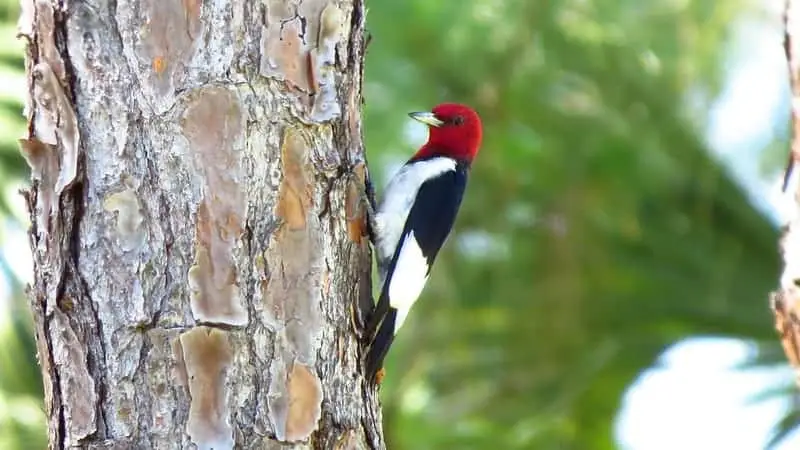
Wingspan
16 inches
Weight
2.5 ounces
Life Expectancy
9 Years
Diet
Insects & Berries
The Red-Headed Woodpecker is a beautiful bird with a bright red set of head feathers that are easy to spot.
These birds are known to form strong bonds during the mating season and will actively seek out a nice area with plenty of deadwood to make their nest.
During the incubation period of the eggs, these birds are known to work together, both male and female, to incubate the eggs and keep them warm.
Finding these birds is really a matter of being in the right place at the right time. The Red-Headed Woodpecker is known for its beautiful display of colors, but that can be misleading.
In fact, young Red-Headed Woodpeckers actually have brown heads until they are about a year old, making it easy to incorrectly spot them as a different kind of bird.
If you spot what appears to be one but looks a little different towards the end of summer, you might be right. Fortunately, as they get old, they get their signature pattern.
These birds are known to stay in wooded and somewhat populated areas.
They are incredibly widespread across the Rocky Mountains, making Colorado a good location for then.
These adorable birds can be spotted nesting in deadwood trees, fence posts, and sometimes under covered roofs.
During breeding season, they have been known to go deeper into the forest in hopes of finding a better place to nest.
12. American Three-toed Woodpecker
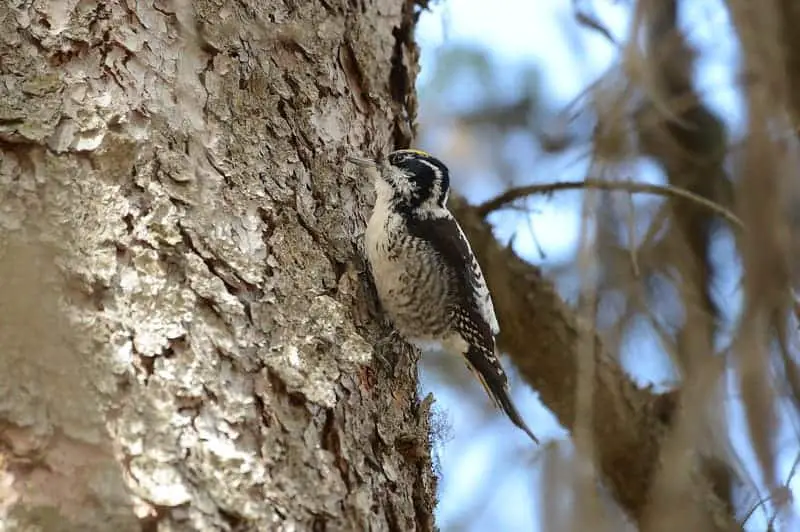
Wingspan
15 inches
Weight
2 ounces
Life Expectancy
6 Years
Diet
Beetle Larvae, insects & fruit
The American Three-Toed Woodpecker is a beautiful bird with a fairly good reputation in Colorado.
These birds are known for their distinct interest in the pine beetle, which has plagued Colorado’s beautiful forests for some time now.
Fortunately, these woodpeckers are able to thin the population of the destructive beetles. This particular woodpecker can easily be found in nest cavities lined with wood chips while they raise their young.
The male will initiate the process and the female will help to finish it.
This particular woodpecker is a nonmigratory bird, but that doesn’t mean that it always stays put.
The American Three-Toed Woodpecker has been known to move around to find a new habitat that is rich in nutrients.
If it gets cold and the bugs leave in winter, this particular bird might just follow. Otherwise, it can be spotted in its usual habitat around the year.
Colorado is a good place to live for the American Three-Toed Woodpecker.
Though they are more concentrated up north, Colorado provides the perfect kind of habitat and food supply for these birds in particular.
Their preference for trees, both dead and alive, as well as beetles, makes Colorado a ripe habitat for them that allows them to easily meet all of their needs.
With the widespread pine beetle problem, these not-so-little birds can actually enjoy quite the feast while also helping out the local tree population.

More Articles.
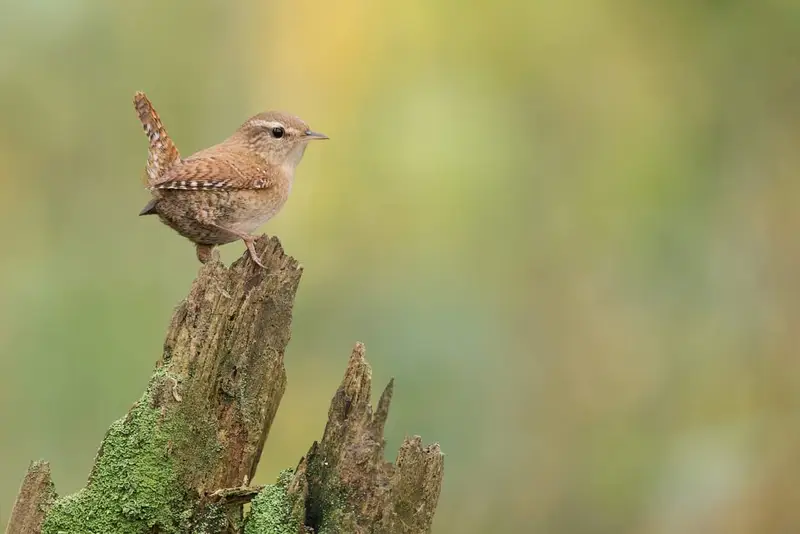
How to Attract Wrens to your Yard?
Wrens are adorable birds that many people enjoy having in their yards. These birds are
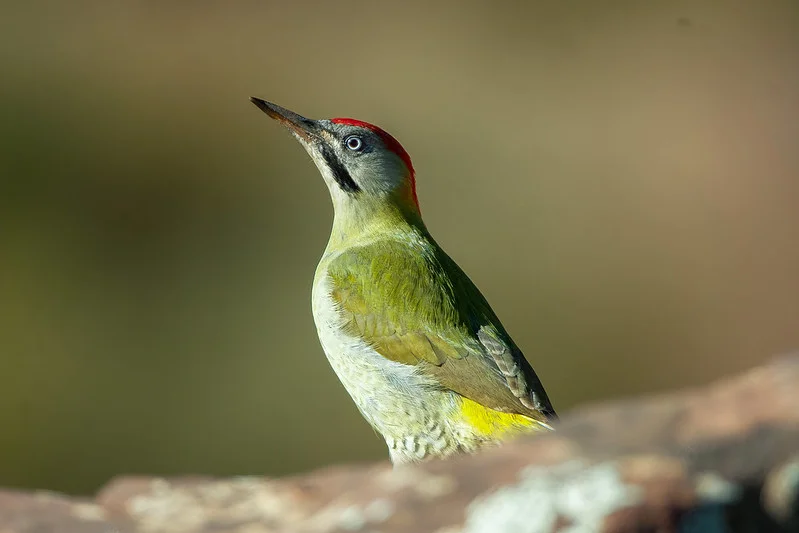
What Woodpeckers can you see in Spain? (8 Species with Pictures & Sounds)
What woodpeckers can you see in Spain? There are 8 different species of woodpecker that

North American Birds with Yellow Bellies (34 Species with Pictures and Sounds)
Canada and America are filled with many wonderful birds with yellow bellies – in fact,

About Us
We are avid bird-watchers who recently retired, allowing us more time to travel the world. Fortunately, we have managed to visit numerous countries around Europe, Asia, and America. Watching and photographing birds has been a passion for many years and we are making the most of the extra time on our hands!
